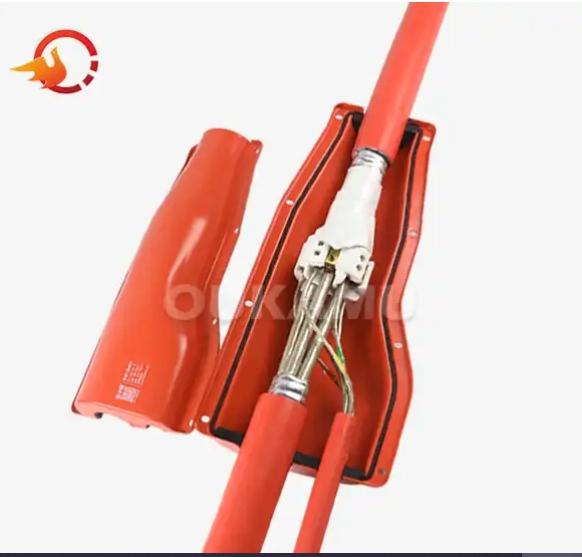Low voltage cable joints are critical components in electrical systems, whether they’re part of a residential home, commercial building, or industrial facility. They ensure the smooth and safe transfer of electrical power between cables, allowing electrical circuits to function efficiently. However, just like any other electrical component, low voltage cable joints are prone to wear and damage over time. Therefore, maintaining and extending their lifespan is essential to prevent costly repairs and potential safety hazards. In this blog, we will explore various strategies for maintaining low voltage cable joints, the common mistakes to avoid, and the benefits of new technologies like OUKAMU's innovative Branch Cable system.
1. Why Do Low Voltage Cable Joints Fail?
Understanding the primary causes of low voltage cable joint failure is essential for preventing issues and ensuring the longevity of your electrical systems. Several factors can contribute to joint failure, including poor installation practices, environmental conditions, overloading, and general wear and tear.
Poor Installation Practices
The foundation of a good electrical system starts with proper installation. Low voltage cable joints are no exception. Improper installation can lead to numerous problems, such as loose connections, high resistance, overheating, and short circuits. Common installation mistakes include:
- Incorrect cable preparation: If the cables are stripped too much or too little, it can expose the conductor or leave insufficient length for a secure connection, resulting in a weak joint.
- Wrong connectors: Using inappropriate connectors for the cable type can compromise the joint, leading to poor electrical contact and eventual failure.
- Improper sealing: Moisture, dust, and contaminants can infiltrate poorly sealed joints, leading to corrosion and insulation damage.
Environmental Factors
Environmental conditions play a significant role in the degradation of low voltage cable joints. Factors such as temperature fluctuations, humidity, chemical exposure, and physical stress can accelerate wear. For example:
- Corrosion: Humidity and exposure to chemicals or salt can cause corrosion of the metallic parts inside the joint, weakening the connection.
- Temperature extremes: High heat can cause the insulation material to degrade or the joint to overheat, while extremely cold temperatures can make materials brittle and prone to cracking.
- Vibration and physical stress: Cables subjected to constant movement or physical strain are more likely to suffer from mechanical stress, leading to joint failure over time.
Overloading and Electrical Stress
Low voltage cable joints are rated to handle specific electrical loads. When they are exposed to higher-than-expected currents or voltage surges, the extra electrical stress can cause overheating, insulation breakdown, or even fires. Common issues related to overloading include:
- Excessive current: When the joint is exposed to higher currents than it was designed for, it can overheat, damaging the insulation and the conductive material.
- Voltage spikes: Surges in voltage, such as those caused by lightning or other electrical events, can break down the insulation, leading to electrical arcs and failure.
2. How Can Regular Maintenance Prevent Low Voltage Cable Joint Failures?
Regular maintenance is one of the most effective ways to extend the lifespan of low voltage cable joints. Through routine inspections and proper care, you can identify potential issues before they develop into major problems.
Inspection and Monitoring
The first step in maintaining low voltage cable joints is a regular inspection. Periodically checking your electrical system will help you spot early signs of trouble, such as:
- Corrosion: Any sign of rust or oxidation around the joint could indicate the presence of moisture or harmful chemicals. This corrosion can significantly reduce the lifespan of the joint if left untreated.
- Loose connections: Over time, vibration or thermal cycling can cause connectors to loosen, increasing electrical resistance and the risk of overheating or arcing.
- Physical damage: Look for cracks, cuts, or other physical signs of wear in the cable insulation and joint materials.
Cleaning and Tightening
To ensure proper function, keep the cable joints clean and well-maintained. Dirt, dust, and debris can build up around the joint, which can affect the conductivity of the connection and increase the chances of overheating. Regular cleaning involves:
- Use of soft brushes: Gently clean the area around the cable joint with a soft brush to remove debris.
- Avoid harsh chemicals: Don't use strong solvents or abrasive tools that could damage the joint. Use a mild cleaner if needed.
- Tightening connections: Over time, connectors can loosen, so be sure to check and re-tighten all connections as necessary. However, be cautious not to overtighten, as this could cause mechanical damage.
Regular Testing
Using tools like a multimeter or continuity tester, check the electrical flow through the joint to detect any irregularities. High resistance or broken connections can often be detected through a simple continuity test. Regular testing ensures that the joint is performing at optimal levels and can help prevent more significant electrical issues in the future.
3. What Are the Best Practices for Installing Low Voltage Cable Joints?
Proper installation is essential for the long-term performance and safety of low voltage cable joints. Following industry standards and best practices can prevent many of the common causes of joint failure.
Choosing the Right Joint
One of the first steps in proper installation is selecting the correct joint for the application. Low voltage cables are designed to operate within specific voltage ranges, and the joint must be compatible with both the cable and the electrical system's needs. Make sure to choose joints that are rated for the correct voltage and current specifications.
Cable Preparation
Before installing the joint, ensure that the cables are prepared correctly. Proper cable stripping and cleaning are essential for making a secure and reliable connection:
- Strip the cables correctly: Remove just enough insulation to expose the conductor, ensuring that no part of the conductor is left exposed. Too much stripping can lead to an unstable connection, while too little can result in a poor contact point.
- Clean the cables: Dirt and corrosion can interfere with the joint’s performance. Clean the exposed conductors with a cloth or specialized cleaner before installation.
Secure the Joint
Once the cables are prepared, it's important to properly connect the joint. Use the appropriate tools, such as crimping or torque wrenches, to ensure the joint is securely fastened. Over-tightening or under-tightening can both lead to poor connections, so always follow manufacturer guidelines for the correct torque settings.
Sealing the Connection
Properly sealing the joint is critical for protecting it from environmental elements. Moisture, dirt, and chemicals can cause corrosion and insulation damage if they infiltrate the joint. Use heat shrink tubing or cold shrink sleeves to create a durable, moisture-resistant seal around the joint.
4. How Can OUKAMU’s Branch Cable Technology Revolutionize Low Voltage Cable Connections?
OUKAMU has developed an innovative solution for low voltage cable systems—the Branch Cable system. This cutting-edge technology offers a new way of branching electrical connections, which simplifies the installation process and reduces the number of failure points in an electrical system.
The Branch Cable System: A New Era in Cable Connectivity
The Branch Cable system allows multiple cables to branch out from a single cable, reducing the need for multiple joints and minimizing the chances of failure. Unlike traditional methods, which rely on numerous complex junctions, the Branch Cable system simplifies the connection process and increases reliability.
Benefits of the Branch Cable System
- Fewer connection points: With fewer junctions in the system, there is less risk of faults, overheating, or arcing, leading to improved safety and longevity.
- Simplified installation: The system reduces the need for complex junction boxes and connections, making the installation process faster and easier.
- Enhanced durability: With fewer joints and connections to maintain, the overall system is less likely to suffer from wear and tear, leading to a longer lifespan.
- Cost-effective: Fewer connections mean fewer materials and less labor required, making the Branch Cable system a more economical solution in the long run.
OUKAMU’s Branch Cable system is a game-changer for industries such as infrastructure, residential, commercial, and industrial sectors. By simplifying the connection process, the Branch Cable technology offers a safer, more efficient, and cost-effective solution for low voltage cable installations.
5. What Are Common Mistakes to Avoid When Maintaining Low Voltage Cable Joints?
While regular maintenance is essential for ensuring the longevity of low voltage cable joints, there are several common mistakes that can inadvertently cause more harm than good. Understanding these mistakes will help you avoid unnecessary issues.
Skipping Regular Inspections
One of the most common mistakes is failing to inspect cable joints regularly. Neglecting to check for signs of wear, corrosion, or loose connections can lead to serious failures down the road. It's important to schedule routine inspections and take immediate action if any issues are identified.
Incorrect Cleaning Methods
Using harsh chemicals or abrasive cleaning methods can damage the cable joint and insulation, leading to a higher risk of failure. Always use soft brushes and mild cleaning solutions to gently clean the area around the joint.
Delaying Replacements
If you notice signs of damage, such as cracks in the insulation, corrosion, or discoloration due to overheating, don’t wait to replace the joint. Continuing to use damaged joints can lead to more significant issues, including system outages and safety hazards.
References:
- National Electrical Manufacturers Association (NEMA) - www.nema.org
- IEEE Power and Energy Society - www.ieee-pes.org
- The Engineering Toolbox - www.engineeringtoolbox.com
- OUKAMU Official Website - www.okmbranchcable.com






